20 Proven Tactics to Get More High-Quality Backlinks


Hand off the toughest tasks in SEO, PPC, and content without compromising quality
Explore ServicesYour (or your clients’) site is rolling along nicely, but there’s more traffic out there to snag.
SEO backlinks crank up rankings and clicks.
I’ve got 20 battle-tested tactics to land high-quality backlinks that pack a punch 👇
21 Proven Tactics to Build SEO Backlinks
Moves to snag high-quality backlinks like a pro. Lessgo!
1. Guest Posting
Guest posting is when you write a blog post for another site in your niche and snag a link back to your own page, usually in the author bio, but sometimes in the content if they’re cool with it.
It’s a straight-up trade: they get killer content, you get SEO juice and eyeballs.
How:
- Google “[site’s niche] + write for us” or “[site’s niche] + guest post guidelines” (like “SEO + write for us”). Find blogs that play ball.
- Throw them a topic that’s fresh, useful, and fits their style, not a rehashed topic they’ve already tackled themselves. Use a site search to make sure, like, for example, “site:loganix.com link-building basics.”
- Place the link naturally, either in the content (if they’re chill) or in your writer’s bio.
- Follow their guidelines—word count, format, link-placement, whatever—or they’ll leave you on red.
Psst! We offer guest posting services.
2. Broken Link-Building
Broken link-building hunts down dead links on other websites and replaces them with your own content. You spot a link that’s gone 404 not found, reach out to the site owner, and offer up your page as the fix. It’s a straightforward swap: their broken junk for your fresh, working alternative.
How:
- Fire up an SEO tool like Ahrefs’ Site Explorer, punch in a target’s domain (or a site in your niche), and, under the Outgoing links reports, hit Broken links to uncover dead pages they’re linking to.


- Offer your page to the target site as a replacement via email. Dig into the dead page (use Wayback Machine if needed) to see what it was about, then use an appropriate, previously written post or craft a better version on your site. Shoot the site owner a short, straight-to-the-point email: flag the broken link, pitch your content as the fix, and explain why it fits.
3. Skyscraper Technique
The Skyscraper Technique focuses on finding top-performing content in your niche, creating something that blows it out of the water, and then asking the sites linking to the original to switch to your version. Focus on taking what’s already working, making it undeniably better, and leveraging that edge to snag backlinks.
By outdoing the best, you give websites a no-brainer reason to link to you instead: your content’s more valuable, more current, and more impressive.
How:
- Fire up Ahrefs’ Content Explorer, plug in your niche keywords, choose a page you can beat the pants off of, click Backlinks, and sift through who’s linking to them. Look for something solid but beatable, perhaps it’s outdated or missing depth.


- Take that post you found apart and then build yours to outshine it by adding fresh data, deeper insights, better visuals, or more actionable tips. Make it the version everyone wishes they’d found first.
- Refer back to Ahrefs to see who’s linking to the original. Then, hit them with a short, sharp email: explain why your content is superior and how it’ll serve their audience better. Include your link and make it simple for them to use you as a replacement.
4. Competitor Analysis
Competitor analysis means pinching backlink ideas straight from your rivals’ profiles. You peek at where they’re getting their links—perhaps industry blogs, directories, or resource pages—and use that intel to fuel your own link-building.
Why bother? Instead of blindly hunting for opportunities, you’re following a roadmap that’s already worked for someone else in your niche.
How:
- Using Ahrefs’ Site Explorer, plug in your domain’s URL, and under the Organic search reports, hit Organic competitors. Then, click the down arrow next to the competitor you’d like to inspect, and click Backlinks.

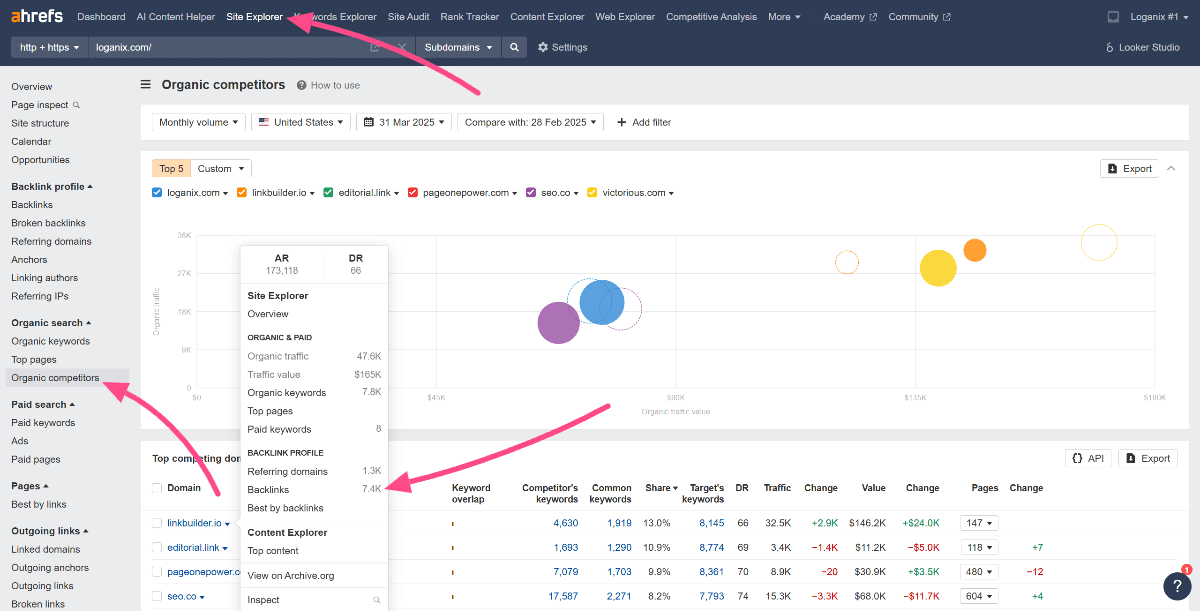
- In the Backlink report, you’ll get a list of every site linking to them, complete with details like domain authority and traffic—your starting point for cherry-picking winners.

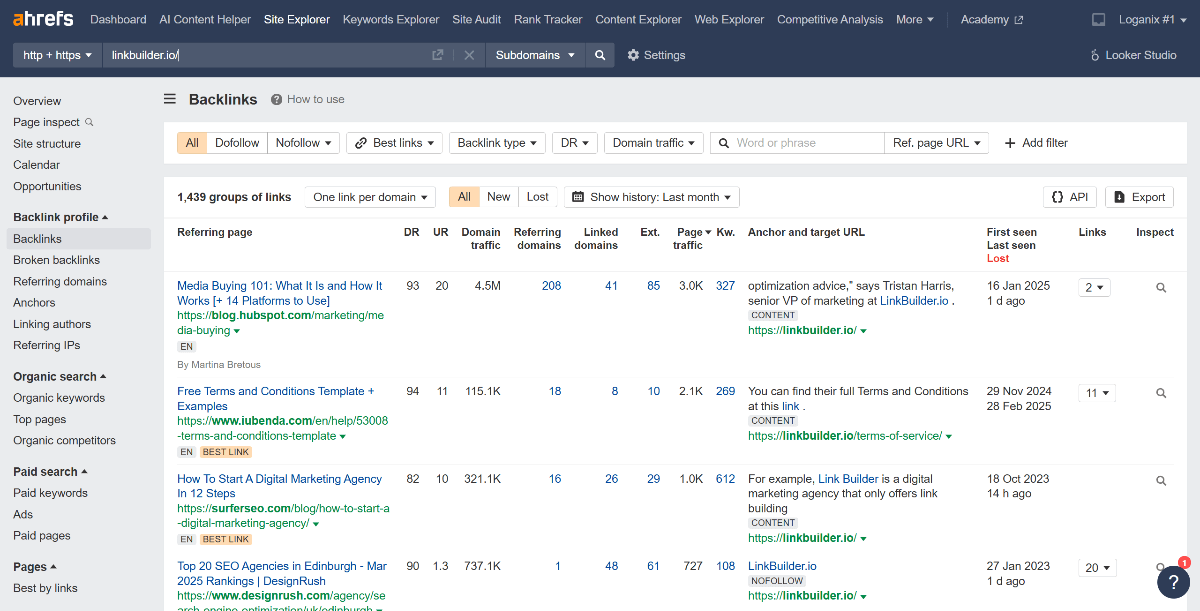
- Pick out the best sites from their profile, ones that are relevant, high-quality, and actually worth your time. Then, hit them with a sharp, tailored pitch that beats what your competitor offered, whether it’s a guest post, a resource swap, or something slicker.
5. Resource Page Link-Building
Resource page link-building gets your website or content listed on resource pages within your niche. These are curated pages, often found on industry blogs, educational sites, or directories, that compile useful links, tools, or guides for their audience.
How:
- Fire up Google and use search operators like “niche + resource page” (e.g., “fitness + resource page”) to hunt down relevant pages.
- Pitch your content, say, a blog post, tool, or guide, as a must-add, keeping it short and showing why it fits their list.
6. HARO/Qwoted
HARO is dead. RIP. That isn’t to say that journalists don’t still use platforms like Qwoted and SourceBottle services to get expert insights for their upcoming stories. That expert could be you.
You sign up, spot a query that matches your know-how, and pitch a response. If the journalist bites, they’ll quote you and, bam, drop a backlink to your site in the piece.
How:

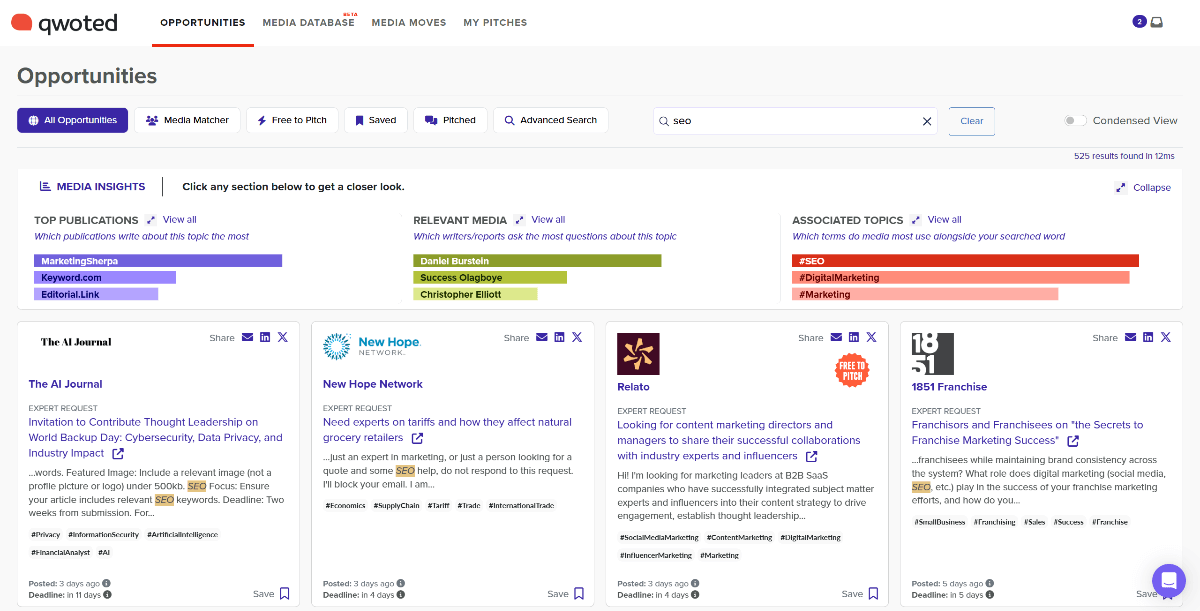
- There are a whole ton of HARO alternatives that are free to join. Qwoted’s big in the U.S., SourceBottle’s got an Aussie tilt but works worldwide.
- Journalists are on tight deadlines, so keep your finger on the pulse and reply within hours with a sharp, 100-200-word answer that nails their question.
- Set up alerts for keywords like “marketing” or “tech” so you’re not drowning in irrelevant requests.
- Toss in a quick line (e.g., “10 years running SEO campaigns”) to prove you’re legit.
- Sometimes the journalist will contact you or mark that your pitch was included in their story on the platform, but not always. So, log your pitches and check for published links using tools like Ahrefs or Google Alerts.
7. Digital PR
Digital PR is all about pitching stories to online publications to snag backlinks and press coverage. The payoff? High-DA (Domain Authority) links that signal to Google your site’s legit, boosting your rankings while the press exposure puts your brand in front of fresh eyes.
How:

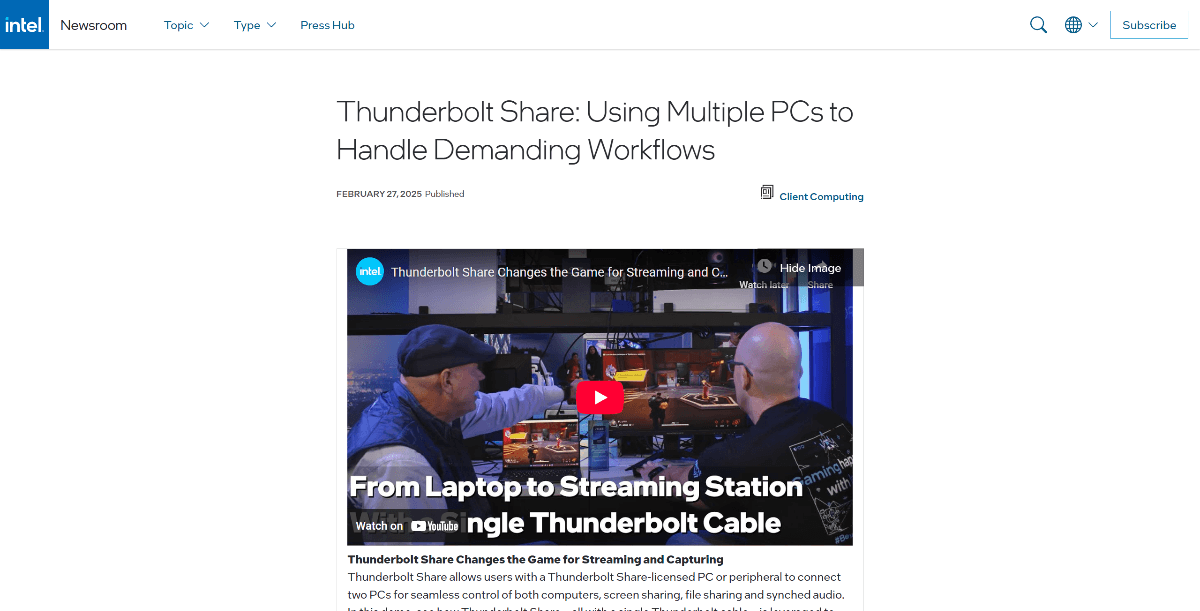
- Craft a newsworthy angle. Dig up unique data, run a quick survey, or spin a trending topic into something fresh like “How X Industry’s Y Stat Doubled in 2025.” Make it irresistible.
- Pitch to niche journalists via email. Find writers covering your beat on a platform like Qwoted or X, then hit them with a short, sharp email. Lead with the hook, explain why their readers care, and keep it under 150 words.
Lost? Good news! We offer PR services.
8. Influencer Outreach
Influencer outreach is a tactic where you team up with social media influencers to get them to mention or link to your content. It’s about collaborating with people who’ve already built a following—think X or Instagram personalities—and convincing them to drop a link to your site in their posts, stories, or bios.
How:
- Dig into platforms where your audience hangs out by searching hashtags, exploring follower lists, or using tools like BuzzSumo to pinpoint influencers whose content fits your brand.
- Don’t ask for favors. Instead, give them something juicy, like a free tool, a product sample, or exclusive content they can share with their following. Make it a no-brainer for them to say yes.
- Reach out with a short, personal message that shows you’ve done your homework. Mention their work, explain why your content fits their audience, and keep it real.
- Give it a week, then send a polite nudge. Stay cool but persistent to seal the deal.
- Track what you get—backlinks, traffic, shares—using tools like Google Analytics or Ahrefs, so you know what’s working and what’s not.
9. Roundup Posts
Getting featured in roundup posts is a no-brainer for backlinks because they’re curated by content aggregators—folks who already know how to draw a crowd. When they include you, you snag an easy link from a site that’s likely got some SEO juice, boosting your own authority and sending traffic your way.
How:


- Hit Google with queries like “inurl:round-up post [niche]” or “expert roundup + niche” to dig up blogs running these articles.
- Find the curator (usually the blog owner or editor) via the site’s contact page or a tool like Hunter.io. Send a short, sharp pitch: who you are, why you fit, and a unique angle they’ll want.
10. Interviews
Giving interviews involves talking to someone with an audience—bloggers, podcasters, whoever—and they post your insights with a link to your site. You’re essentially trading your knowledge for digital real estate on a platform that’s already got traction.
How:
- Hunt down players in your space by using X, LinkedIn, or a quick Google search. Focus on active sites, podcasts, or whichever medium it is, with real followers.
- Pitch something juicy, their audience will eat up—like “3 unsexy SEO wins that crush it”—and weave in a natural ask for a backlink. Sweeten the deal with a bonus (like a link exchange) so they’re stoked to say yes.
- Do your homework. Skim the target’s past stuff, prep tight talking points, and deliver value. Half-ass it, and you’re just noise; nail it, and you’ve got a link plus a rep that opens more doors.
11. Case Studies
Case studies mean publishing original research, like surveys, experiments, or data analyses, to earn link citations. The aim is to create something new, not just parroting what’s out there. Think of it as rolling up your sleeves, digging into your niche, and sharing findings that others can’t ignore.
How:

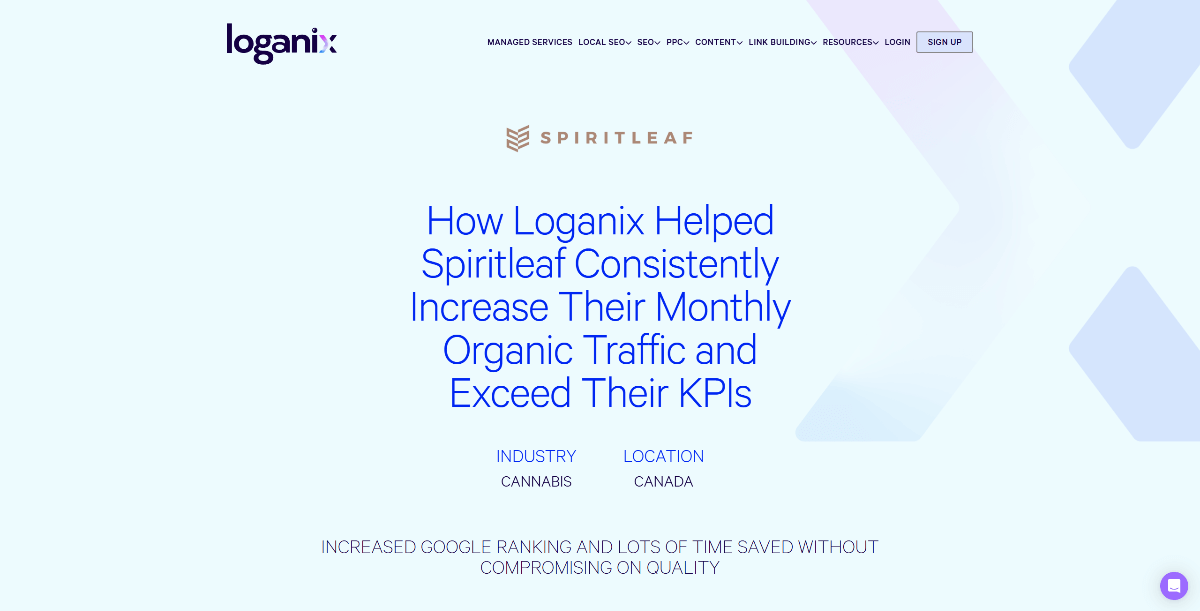
- Find something your audience cares about that’s light on fresh data.
- Choose your method. A survey works for opinions; data scraping or analysis is suited for trends.
- Run a survey with tools like Google Forms or SurveyMonkey, targeting a solid sample size. Dig into your customer data. Or pull data from reliable sources if you’re analyzing trends.
- Analyze your results. Use Excel, Google Sheets, or stats software to spot the juicy bits.
- Turn your findings into a blog post, infographic, or report. Add charts or graphs to make it visual and easy to skim.
- Promote it to bloggers and journalists in your niche. Send emails with a killer hook. Hit social media, too.
- Answer comments, chat in forums, and push anyone who engages to share it. The more noise, the more links.
12. Newsjacking
Reporters are freaking out trying to cover breaking news, and they need angles fast. If you’ve got something solid, like a stat or a take they can use, they’ll grab it. You score a link from a heavy-hitter site and some eyeballs from people obsessed with the story. It’s all about timing and actually having something worth a damn to say.
How:
- Monitor Google News or X for hot topics. Set up alerts for industry keywords or follow trending hashtags to catch stories as they break.
- Pick a story that aligns with your content. Find a natural tie-in, perhaps your data, insights, or resources, should enhance what’s being reported.
- Craft a tight pitch. Keep it short, sharp, and focused. Tell reporters why your content matters to their story in 100 words or fewer.
- Target the right reporters. Dig up who’s writing about the topic (try Muck Rack or X searches) and hit them up via email or social media.
- News moves at warp speed, so get your pitch out within hours, not days, to stay relevant.
13. Testimonials
Testimonials earn backlinks by offering reviews or success stories. You write a genuine endorsement for a tool, service, or product you’ve used, and in return, the company links back to your site, often from their testimonials page, homepage, or product section.
It’s a simple exchange: you provide them with credible praise they can showcase, and they toss you a link to boost your own site.
How:

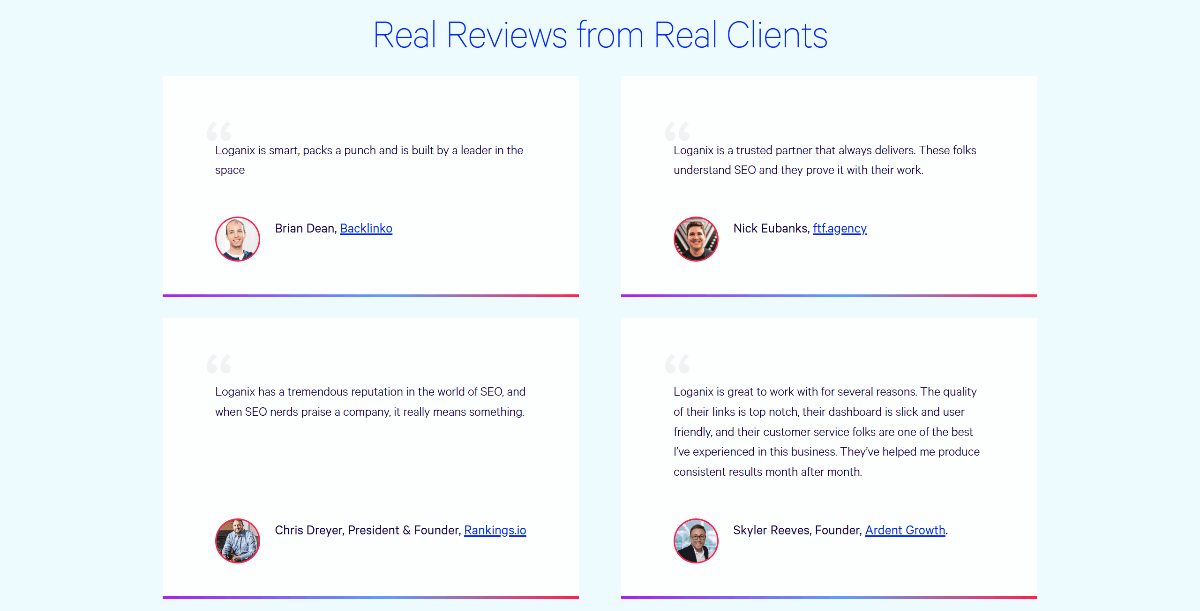
- Write a testimonial for a tool or service you love. Pick something you genuinely use because authenticity is key. Make it specific, 100-200 words, highlighting what it does for you and why it stands out.
- Reach out with a short, friendly email: “I’ve written a testimonial about [tool] and I thought it might fit your site. Could you link back to mine if you use it?” Follow their submission process if they have one, and follow up politely if you don’t hear back in a week.
14. Sponsorships/Scholarships
Sponsorships and scholarships are straightforward backlink plays where you fund events or awards to score links from .edu and .org domains. Think sponsoring a local conference, a community event, or an industry meetup, or setting up a scholarship for students or pros with a grant or cash prize.
How:
- Hunt down events, conferences, or groups in your niche tied to .edu or .org domains, anything that fits your brand’s vibe.
- Hit them with a tight proposal. Spell out how your funding helps and why you’re the right partner.
- Nail down terms that guarantee a backlink, ideally on a high-traffic page like their event or scholarship rundown.
- Pay up, deliver what you promised, and double-check the link’s live and pointing where it should.
15. Local Listings
Local listings or citations are online directories or sites where you can park your business’s details… name, address, phone number, website, you name it. We’re talking Google My Business, Yelp, or even smaller, local-focused platforms.
How:

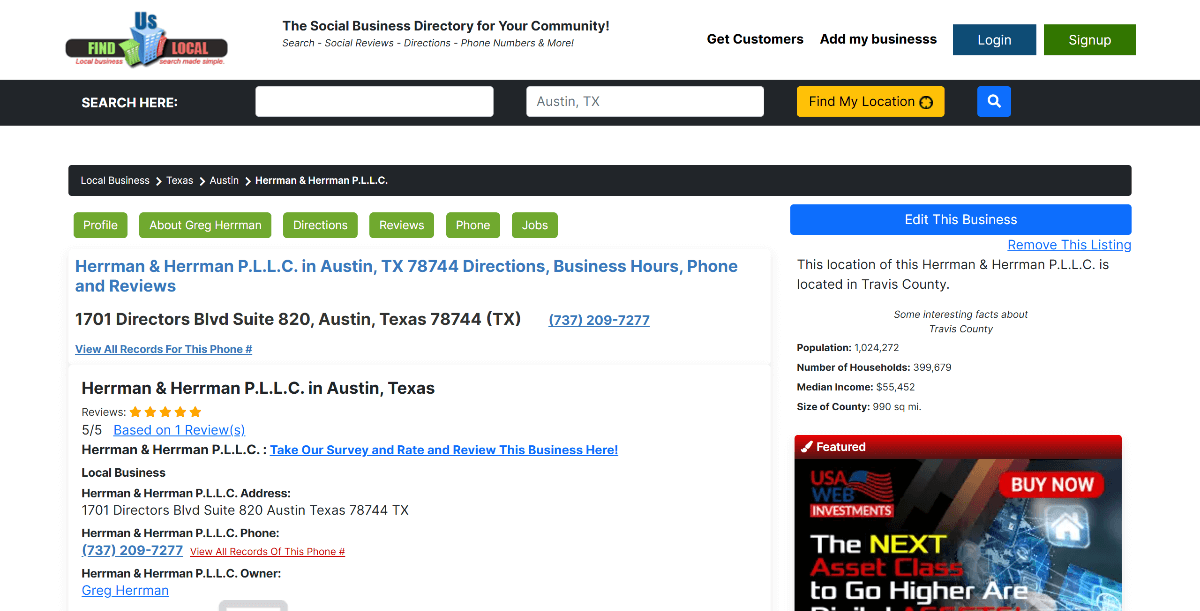
- Hit the big names first, like Google My Business, Yelp, and Bing Places. Sign up, fill out your profile, and verify it (usually a quick code by mail or phone). These are your bread-and-butter listings.
- Dig into directories tied to your industry or area, think Nextdoor for neighborhood gigs or Healthgrades for doctors. Search “[your industry] + local directory” or “[your city] + business listings” to find them. Get listed, and watch the local love roll in.
Need help? We offer local citation-building services.
16. Industry Associations
Industry associations are professional groups or trade organizations tied to specific fields, like the National Retail Federation or the American Bar Association. Joining these groups often gets you a spot on their member pages, typically in an online directory that lists member businesses or professionals with a link back to their websites.
It’s a straightforward tactic: sign up, get listed, and secure a backlink from their site to yours.
How:
- Search for groups in your industry—like “[your niche] trade association” or “[your niche] professional group”—and pick ones with member directories offering backlinks. Check their rep and relevance before committing.
- After joining (usually via an application and fee), submit your website details for the listing. Provide a short business blurb and your exact URL.
17. Social Media
When you push out valuable, share-worthy content on platforms like X or LinkedIn, you’re putting it in front of people who might link back to your site: bloggers, journalists, or industry players.
The goal? Amplify your reach to score organic link pickups. It’s not about the social links themselves (those are usually nofollow anyway), but about increasing visibility so your content catches the eye of someone with a site who’ll drop a natural, juicy backlink.
How:
- Craft content that fits the platform. Something that’s short, sharp posts with bold visuals or hashtags for X; polished, in-depth updates or articles for LinkedIn. Make it irresistible to click and share.
- Find influencers in your niche and get them involved. Tag them, ask for a share, or co-create something. Their audience is your ticket to bigger reach and more link opportunities.
- Use calls-to-action, questions, or polls to get people liking, commenting, and sharing. Higher engagement boosts visibility, upping the odds of someone linking back.
- Track your posts with tools like Hootsuite or Sprout Social. See what’s hitting and double down on it to keep the backlink potential growing.
18. Forums/Reddit
Dropping links in niche discussions on forums and Reddit is a smart, targeted way to build backlinks. These platforms are goldmines of engaged users. By jumping into these discussions and strategically placing links to your content, you’re putting your site in front of audiences who are primed to care.
The payoff? Backlinks from real people who value what you’re offering.
How:


- Hunt down the right spots where your audience hangs out. Use Google, Reddit’s search bar, or tools like Ahrefs to find active subreddits and forums tied to your keywords.
- Don’t be that guy who spams links on day one. Start by contributing. Answer questions, share tips, and add something useful. Build trust. Then, when it fits, drop your link naturally.
- Every community has guidelines. Read them. Follow them. Some ban self-promotion outright; others have specific threads for it. Stay on the right side of the line to avoid a ban.
- After posting a link, don’t vanish. Reply to comments, answer follow-ups, and keep the conversation alive. It shows you’re legit, not just fishing for clicks.
19. Paid Promotion
Waiting for people to find your content on their own? Good luck. That takes forever. Paying up puts it right in front of folks who might actually care, like niche bloggers or industry nerds.
How:
- Where’s your crowd at? Google Ads, X, maybe a niche forum? If you’re in SEO, try sponsoring a newsletter or something marketers read.
- Write a killer guide, drop some fresh data, something people can’t ignore.
- Don’t just throw money everywhere. Target ads at people searching stuff like “backlink tricks” or poking around SEO circles.
- Watch your results. One ad’s killing it while another’s a dud? Put your cash where the links are.
20. Community Involvement
Community involvement is all about engaging locally to snag backlinks. Whether you’re hosting a charity gig, joining a street fair, or backing a local team, the goal is to get noticed by community websites, event pages, or blogs that can link back to you. It’s grassroots link-building with a local twist.
How:
- Pick something that vibes with your brand. Host a workshop, sponsor a fun run, or volunteer at a local cleanup. Show up and own it.
- Reach out to organizers, chambers of commerce, or bloggers to feature your involvement. Make it worth their while by giving them content or a story to share.
- Document your effort with photos or a quick write-up, then pitch it to local news sites or community boards. A link from them is gold.
- Connect with area influencers like bloggers, social media regulars, or even the guy who runs the town newsletter. Get them to mention you.
- Don’t just chase links, actually give a damn. Authentic involvement beats a hollow PR stunt every time.
Conclusion and Next Steps
You’ve just unlocked 20 proven tactics to score high-quality backlinks. Nice!
But here’s the truth: link-building isn’t a walk in the park. It takes time, effort, and a solid dose of persistence.
If you’re stretched thin or want results without the grind, Loganix is here to step in.
Our link-building services deliver the premium backlinks your site craves, minus the stress.
👉 Hit up our link-building services page and let’s make your site stand out. 👈
Hand off the toughest tasks in SEO, PPC, and content without compromising quality
Explore ServicesWritten by Aaron Haynes on April 10, 2025
CEO and partner at Loganix, I believe in taking what you do best and sharing it with the world in the most transparent and powerful way possible. If I am not running the business, I am neck deep in client SEO.















